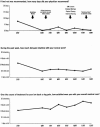Continuous quality improvement for patients with back pain
- PMID: 11029679
- PMCID: PMC1495586
- DOI: 10.1046/j.1525-1497.2000.90717.x
Continuous quality improvement for patients with back pain
Abstract
Recent evidence has changed traditional approaches to low back pain, suggesting minimal bed rest, highly selective imaging, and early return to normal activities. However, there are wide geographical variations in care, and substantial gaps between practice and evidence. This project sought to merge scientific evidence about back pain and knowledge about behavior change to help organizations improve care for back pain. Participating insurance plans, HMOs, and group practices focused on problems they themselves identified. The year-long program included quarterly meetings, coaching for rapid cycles of change, a menu of potential interventions, and recommendations for monitoring outcomes. Participants interacted through meetings, e-mail, and conference calls. Of the 22 participating organizations, 6 (27%) made major progress. Typical changes were reduced imaging, bed rest, and work loss, and increased patient education and satisfaction. Specific examples were a 30% decrease in plain x-rays, a 100% increase in use of patient education materials, and an 81% drop in prescribed bed rest. Despite the complexity of care for back pain, rapid improvements appear feasible. Several organizations had major improvements, and most experienced at least modest improvements. Key elements of successful programs included focus on a small number of clinical goals, frequent measurement of outcomes among small samples of patients, vigilance in maintaining gains; involvement of office staffs as well as physicians, and changes in standard protocols for imaging, physical therapy, and referral.
Figures


Comment in
-
Two kinds of knowledge to achieve better care.J Gen Intern Med. 2000 Sep;15(9):675-6. doi: 10.1046/j.1525-1497.2000.00720.x. J Gen Intern Med. 2000. PMID: 11029684 Free PMC article. No abstract available.
References
-
- Bigos S, Bowyer O, Braen G, Brown K, Deyo R, Haldeman S, HArt JL, Johnson EW, Keller R, Kido D, Liang MH, Nelson RM, Nordin M, Owen BD, Pope MH. Acute low back problems in adults. Clin Prac Guideline No. 14, AHCPR. 1994:95–0643. Publication.
-
- Schroth WS, Schectman JM, Elinsky EG, Panagides JC. Utilization of medical services for the treatment of acute low back pain: conformance with clinical guidelines. J Gen Intern Med. 1992;7:486–91. - PubMed
-
- Swedlow A, Johnson G, Smithline N, Milstein A. Increased costs and rates of use in the California workers' compensation system as a result of self-referral by physicians. N Engl J Med. 1992;327:1502–6. - PubMed
Publication types
MeSH terms
LinkOut - more resources
Full Text Sources
Medical
